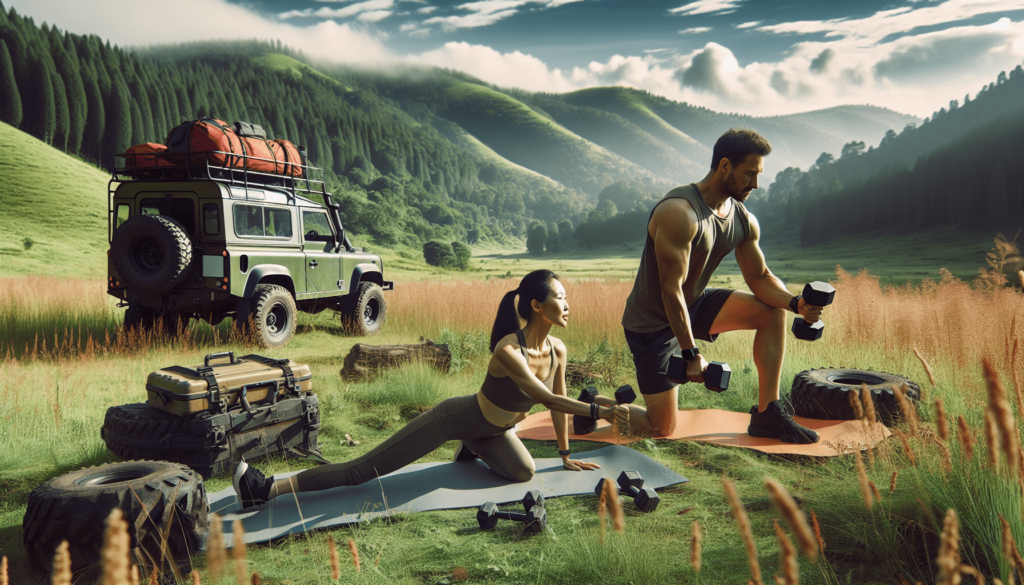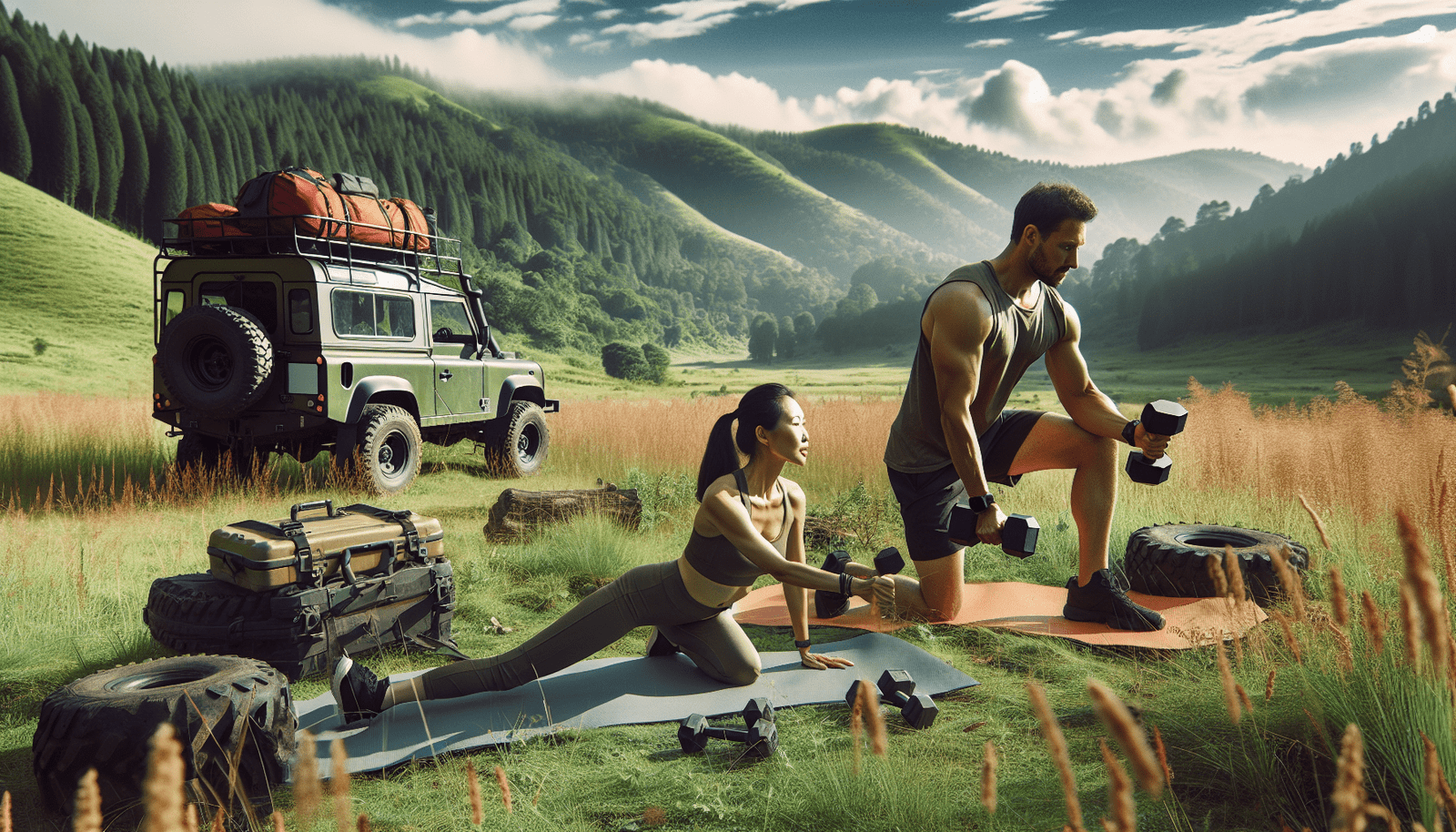Hey, adventurer! We know how thrilling it is to embark on daring overland escapades, but let’s not forget the importance of keeping our bodies in tip-top shape during these exhilarating journeys. So, how exactly can you stay fit while overlanding? Well, fear not, for we have some valuable tips up our sleeves that will help you maintain your fitness levels while exploring the vast, rugged terrains. From staying active on the road to making smart choices when it comes to food, we’ve got you covered. Let’s dive in and discover how you can stay fit and fabulous while on your overlanding adventures!

Create a Fitness Plan
Set Fitness Goals
To stay fit while overlanding, it’s important to set specific fitness goals. Determine what you want to achieve physically and mentally through your fitness routine. Whether it’s building strength, improving flexibility, increasing endurance, or simply maintaining overall health and well-being, having clear goals will help guide your workouts and keep you motivated.
Choose Exercises
When it comes to choosing exercises for your fitness plan, it’s best to incorporate a variety of activities to target different muscle groups and prevent boredom. Bodyweight exercises, such as push-ups, squats, and planks, can be easily done anywhere and require no equipment. High-intensity interval training (HIIT) workouts are great for burning calories and improving cardiovascular fitness. Yoga and Pilates are excellent for improving flexibility, balance, and core strength. And if you enjoy the outdoors, hiking and trekking are fantastic options to engage in physical activity while exploring new places.
Determine Frequency
Finding the right frequency for your workouts is crucial. Aim for at least 150 minutes of moderate-intensity aerobic exercise or 75 minutes of vigorous-intensity exercise per week, along with two or more days of strength training. However, you can customize this based on your fitness level, time availability, and personal preferences. Listen to your body and gradually increase the duration and intensity of your workouts over time.
Design a Workout Schedule
To successfully incorporate fitness into your overlanding lifestyle, it’s essential to create a workout schedule that aligns with your travel plans. Consider your daily activities and find opportunities to squeeze in short exercise sessions. Whether it’s early in the morning, during breaks, or in the evening, identify the best times for your workouts. Be flexible with your schedule and adapt it to fit the different environments and challenges you may encounter during your overlanding journey.
Exercise Options
Bodyweight Exercises
Bodyweight exercises are a convenient and effective way to stay fit while overlanding. They require no equipment, and can be done anytime, anywhere. Push-ups, squats, lunges, burpees, and mountain climbers are just a few examples of bodyweight exercises that target multiple muscle groups and promote strength and endurance.
HIIT Workouts
HIIT workouts are perfect for those short on time but still want to get an intense and efficient workout. These workouts involve short bursts of high-intensity exercises followed by brief recovery periods. HIIT exercises can include jumping jacks, high knees, squat jumps, and plank variations. Not only do these workouts burn calories, but they also improve cardiovascular fitness and boost metabolism.
Yoga and Pilates
Yoga and Pilates are excellent options for improving flexibility, balance, and core strength, no matter where you find yourself during your overlanding adventures. Yoga focuses on connecting the mind and body through a series of poses, while Pilates emphasizes core stability and control. Both disciplines offer various levels of intensity, making them suitable for beginners to advanced practitioners. All you need is a yoga mat and some space to reap the benefits of these mind-body practices.
Hiking and Trekking
If you love being in the great outdoors, hiking and trekking are fantastic ways to incorporate exercise into your overlanding journey. These activities not only provide a cardiovascular workout but also allow you to connect with nature and explore new surroundings. Research hiking trails and trekking routes in the areas you plan to visit, and make sure to pack appropriate gear, such as comfortable hiking shoes and a backpack with essentials like water and snacks.
Fitness Equipment
Resistance Bands
Resistance bands are lightweight, versatile, and travel-friendly fitness tools that can be easily incorporated into your overlanding fitness routine. They provide resistance to help build strength and tone muscles. With a set of resistance bands, you can target various muscle groups by performing exercises such as bicep curls, shoulder presses, squats, and glute bridges. Include resistance band training in your workouts for added challenge and variety.
Dumbbells or Kettlebells
If you have space in your vehicle or are staying in a place with access to weights, incorporating dumbbells or kettlebells into your workouts can bring your strength training to the next level. These free weights allow you to target specific muscles and increase resistance for an effective full-body workout. Consider bringing a set of dumbbells or kettlebells with different weights to accommodate different exercises and fitness levels.
Skipping Rope
Skipping rope is a simple yet effective cardio exercise that requires minimal space and equipment. It’s a great way to get your heart rate up and improve coordination and agility. Pack a skipping rope in your overlanding gear and take advantage of those spare moments to jump rope and get your blood flowing. Vary the intensity by incorporating different jump rope techniques, such as double unders, single leg jumps, or alternate foot jumps.
Yoga Mat
A yoga mat is a staple piece of equipment for anyone interested in practicing yoga or Pilates. It provides a stable and comfortable surface for your workouts, whether indoor or outdoor. A yoga mat not only offers cushioning for your joints but also helps maintain grip during yoga poses or Pilates exercises. Its lightweight and rollable design make it easy to transport, allowing you to practice your fitness routine wherever you go.
Stay Active during Driving
Stretching Exercises
Sitting for extended periods during overlanding drives can lead to stiffness and discomfort. Incorporating stretching exercises into your driving routine can help alleviate muscle tension and promote blood circulation. Simple stretches, such as neck rolls, shoulder shrugs, ankle circles, and seated twists, can be done while seated in your vehicle or during breaks to keep your body limber and relieve any driving-related stiffness.
Isometric Exercises
Isometric exercises involve contracting your muscles without joint movement. These exercises can be performed while driving and are an effective way to keep your muscles engaged and active. Push against the steering wheel or car seat to work your chest and triceps. Squeeze your glutes and hold for a few seconds to engage your buttocks. Isometric exercises allow you to maintain muscle tone and prevent muscle imbalances during long drives.
Core Strengthening Exercises
Strengthening your core muscles is essential for maintaining a good posture and avoiding back pain during long drives. Incorporate core exercises, such as seated leg lifts, seated side bends, and pelvic tilts, into your driving routine. Engaging your abdominal muscles while driving can help improve your posture, support your lower back, and enhance overall stability. Make it a habit to activate your core muscles throughout your journey to stay fit and comfortable on the road.

Nutrition Tips
Plan Healthy Meals
Maintaining a balanced diet is crucial for staying fit while overlanding. Plan your meals in advance to ensure you have a variety of healthy options available. Include a mix of lean proteins, whole grains, fruits, vegetables, and healthy fats in your meals. Opt for homemade meals whenever possible to have better control over ingredients and portion sizes. Consider investing in a portable cooler or refrigerator to store perishable items during your travels.
Stock Up on Nutrient-rich Foods
When packing up for your overlanding adventure, prioritize stocking up on nutrient-rich foods that can last without refrigeration. These can include nuts, seeds, dried fruits, whole grain crackers, canned tuna, salmon, or chicken, nut butter, and protein bars. These foods are not only convenient but also provide essential nutrients to fuel your body. Incorporate them into your meals and snacks to keep your energy levels high and maintain good nutrition on the go.
Stay Hydrated
Staying hydrated is key to maintaining optimal health and performance while overlanding. Carry a reusable water bottle with you at all times and make it a habit to drink water regularly. The amount of water you need will vary depending on factors like temperature, activity level, and personal preference. Aim to consume at least 8 cups (64 ounces) of water per day. If you’re in a location where access to clean water is limited, consider investing in a portable water filter.
Minimize Processed Foods
While it’s convenient to rely on packaged and processed foods during your overlanding journey, they may not provide the same nutritional value as fresh, whole foods. Minimize your intake of processed foods that are high in added sugars, unhealthy fats, and sodium. Instead, focus on consuming a majority of natural, unprocessed foods. This will not only benefit your physical health but also contribute to your overall well-being.
Balancing Work and Fitness
Prioritize Exercise
Balancing work and fitness while overlanding can be challenging, but it’s important to prioritize exercise for your physical and mental well-being. Set aside dedicated time each day or week to focus on your fitness routine. Whether it’s a morning workout, an evening walk, or a midday stretch break, make it a non-negotiable part of your schedule. By prioritizing exercise, you’ll reap the benefits of improved energy, productivity, and overall health.
Utilize Rest Days
Rest days are just as important as workout days. Allow your body time to recover and repair from the physical demands of overlanding. Rest days can also provide mental rejuvenation and prevent burnout. Use rest days to engage in leisurely activities, explore new places, or simply relax and recharge. Listen to your body and take rest days when needed, ensuring you strike a balance between physical activity and rest.
Incorporate Physical Activities into Work
Finding creative ways to incorporate physical activity into your work can help you stay active and fit while overlanding. If you have a portable laptop or tablet, consider working outside, where you can stand, walk, or stretch while getting your tasks done. Take quick breaks every hour to perform a few minutes of exercise, such as jumping jacks, bodyweight squats, or desk stretches. By integrating movement into your work routine, you’ll stay active and productive throughout the day.
Set Realistic Expectations
It’s important to set realistic expectations when balancing work and fitness during overlanding. Your fitness routine may not always look the same as it would in a regular workweek or gym setting. Embrace the flexibility of your lifestyle and adapt your workouts accordingly. If you’re short on time or don’t have access to traditional workout facilities, focus on incorporating short bursts of physical activity throughout the day. Remember that any exercise is better than none, and making consistent effort is what matters most.
Take Advantage of Nature
Trail Running
When exploring new locations during your overlanding adventures, lace up your running shoes and hit the trails. Trail running not only provides a challenging cardiovascular workout but also allows you to immerse yourself in nature and enjoy scenic views. Research local trails, choose ones that match your skill level, and take proper safety precautions when trail running. Embrace the freedom and connection with nature that comes with this exhilarating form of exercise.
Outdoor Sports
Overlanding offers opportunities to engage in various outdoor sports that can keep you fit and add excitement to your journey. Look for nearby locations where you can enjoy activities like rock climbing, kayaking, stand-up paddleboarding, or mountain biking. These activities engage multiple muscle groups, improve cardiovascular fitness, and enhance coordination and balance. Remember to prioritize safety and proper equipment when indulging in outdoor sports.
Swimming
If you have access to lakes, rivers, or the ocean during your overlanding travels, make a splash and go for a swim. Swimming is a low-impact, full-body workout that provides cardiovascular conditioning and strengthens muscles. It’s a great way to cool off on hot days while improving endurance and overall fitness. Whether it’s a leisurely swim, some laps, or snorkeling, take advantage of the natural bodies of water around you to stay fit and refreshed.
Cycling
Cycling is an excellent way to explore new areas and get a great workout while overlanding. Whether you have a road bike or a mountain bike, find cycling routes that cater to your preferences and skill level. Cycling engages the lower body, including the quadriceps, hamstrings, and gluteal muscles, while also providing a cardiovascular challenge. Enjoy the freedom and scenery as you pedal your way to better fitness.
Utilize Campsite Exercises
Full-Body Circuit
Make the most of your campsite by creating a full-body circuit workout. Combine bodyweight exercises like push-ups, lunges, squats, plank variations, and burpees into a circuit format. Perform each exercise for a certain number of reps or time, and move from one exercise to the next without resting. This will provide a comprehensive workout that targets all major muscle groups and gets your heart pumping.
Yoga Routine
Unroll your yoga mat at your campsite and indulge in a peaceful yoga routine. Yoga not only strengthens and stretches your muscles but also promotes relaxation and mental focus. Design a yoga routine that includes poses for flexibility, strength, balance, and relaxation. Incorporate breathing exercises and a short meditation session to center and calm your mind. Yoga at the campsite can be a peaceful and rejuvenating way to start or end your day.
Resistance Band Workout
Take out your resistance bands and use them for a full-body workout right at your campsite. Resistance band exercises like bicep curls, overhead presses, chest presses, rows, and squats are excellent for building strength and toning muscles. Attach your bands to sturdy objects such as tree trunks or vehicle parts to provide resistance during your exercises. The compact nature of resistance bands makes them ideal for on-the-go workouts.
HIIT Circuit
If you’re short on time but still want an effective workout, try a high-intensity interval training (HIIT) circuit at your campsite. Incorporate bodyweight exercises like jumping jacks, squat jumps, mountain climbers, and planks into a circuit format. Perform each exercise at maximum effort for a set amount of time, followed by a short rest. Repeat the circuit multiple times to elevate your heart rate, burn calories, and improve cardiovascular fitness.
Join Local Fitness Communities
Participate in Group Fitness Classes
One of the great benefits of overlanding is the opportunity to meet new people and immerse yourself in different communities. Seek out local fitness communities and participate in group fitness classes or workouts. Whether it’s a yoga class on the beach, a boot camp in the park, or a group hike, joining these activities can provide motivation, social interaction, and a chance to learn from others. Embrace the sense of camaraderie and support that comes with being part of a fitness community.
Attend Workout Meetups
Check for workout meetups or fitness events happening in the areas you’re visiting during your overlanding journey. These gatherings often bring like-minded individuals together to engage in various physical activities. From running clubs to outdoor fitness boot camps, these opportunities allow you to connect with locals and fellow travelers who share a passion for fitness. It’s a fantastic way to experience different workout styles, gain new perspectives, and make lasting connections.
Join Fitness Challenges or Competitions
For those who thrive on competition and enjoy pushing their limits, consider joining fitness challenges or competitions during your overlanding travels. Look for events such as obstacle course races, triathlons, or local fitness challenges that align with your interests and abilities. Participating in these challenges not only keeps you motivated and pushes you to reach new goals but also introduces you to a network of individuals who share a common passion for fitness and healthy living.
Mindset and Self-Care
Maintain a Positive Attitude
Staying fit while overlanding requires a positive mindset. Embrace the challenges and uncertainties that come with your journey, and see them as opportunities for personal growth. Recognize that not every day will go as planned, but maintain a positive attitude and focus on the progress you have made. A positive mindset will not only improve your overall well-being but also enhance your motivation to stay active and committed to your fitness goals.
Practice Mindfulness and Meditation
Overlanding often takes you to breathtaking natural landscapes and serene environments. Take advantage of these surroundings to practice mindfulness and meditation. Find a quiet spot, sit comfortably, and tune in to your breath and surroundings. Allow yourself to be present in the moment, releasing any worries or distractions. Engaging in mindfulness and meditation can reduce stress, improve mental clarity, and enhance your overall sense of well-being.
Get Enough Sleep
Sleep is a vital component of your overall health and fitness. Adequate rest is essential for muscle repair, hormone regulation, and cognitive function. Despite the excitement of your overlanding adventures, prioritize getting enough sleep each night. Create a sleep routine that aligns with your natural sleep-wake cycle, establish a comfortable sleeping environment in your vehicle or tent, and limit exposure to electronic devices before bed. A good night’s sleep will contribute to better physical and mental performance during your travels.
Prioritize Relaxation
In the midst of your overlanding adventures, it’s important to prioritize relaxation to recharge your body and mind. Engage in activities that help you unwind and destress, such as reading, listening to music, taking nature walks, or practicing gentle stretching. Carve out pockets of time each day to do activities that bring you joy and allow you to relax and recharge. Balancing physical activity with relaxation is key to maintaining a healthy and sustainable overlanding lifestyle.
Staying fit while overlanding requires commitment, creativity, and adaptability. By creating a personalized fitness plan, utilizing different exercise options, making smart nutrition choices, balancing work and fitness, and embracing nature, you can enjoy a fulfilling and active lifestyle on the road. Remember to prioritize self-care and maintain a positive mindset throughout your journey. With determination and flexibility, staying fit while overlanding can be an enjoyable and rewarding experience.

